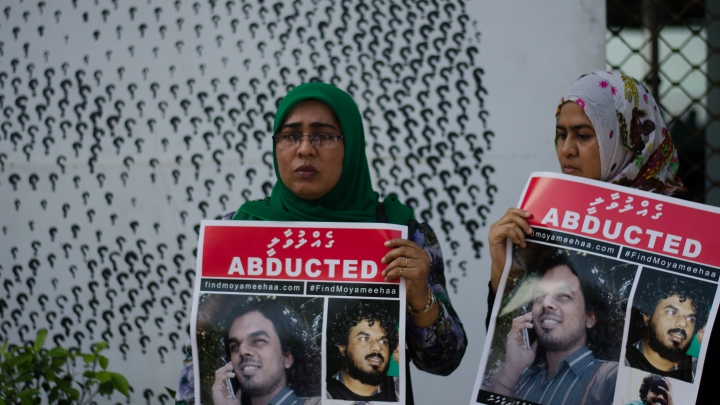The police have said that there is no evidence linking the disappearance of Minivan News journalist Ahmed Rilwan in August last year to a reported abduction outside his apartment in Hulhumalé.
Rilwan’s neighbours had reported seeing a man forced into a red car at knifepoint outside the apartment building in the early hours of August 8, at the same time he would have reached home.
In a statement released today, the police said they have received DNA analysis of samples taken from three cars suspected to have been used in the abduction, but could not “conclusively state” that there was a connection between the incident and Rilwan’s disappearance.
“We also note that this analysis did not provide any evidence of a link to the suspects previously arrested in this case,” the police said.
Four suspects had been arrested in October and one suspect was held in police custody for five weeks, but the Criminal Court transferred him to house arrest in November.
One of the suspects was among a group of 12 Maldivian jihadis who traveled to Syria in January. The group also included Azlif Rauf, a suspect in the murder of MP Dr Afrasheem Ali in October 2012, who reportedly died while fighting in Syria in mid-May.
An investigative report published by Maldivian Democratic Network had identified Azlif’s brother Arlif Rauf as the owner of the red car which may have been used in Rilwan’s suspected abduction.
The report implicated radicalised gangs in Rilwan’s disappearance and confirmed evidence of possible “hostile surveillance” at the terminal conducted by two known affiliates of Malé-based Kuda Henveiru gang led by the Rauf brothers.
Home minister Umar Naseer had also also acknowledged involvement of criminal gangs in the case.
Today’s police statement meanwhile follows Rilwan’s family backing an opposition proposal for an independent inquiry last week. The family also announced plans to hold a march on August 8 to mark one year after Rilwan’s disappearance.
The police vowed to continue efforts to find the missing journalist and the investigation into his disappearance “no matter how long it takes” and urged anyone with information to come forward.
Rilwan’s disappearance was “one of the cases that police investigation teams gave the highest priority to and spent the most time investigating in 2014,” the police said.
Police investigators have questioned 198 people, obtained statements from more than 80 individuals, and retrieved more than 293 hours of CCTV video footage, the statement noted.
The police also searched public spaces, closed areas, and industrial areas in Hulhumalè, the statement continued, and searched more than 50 places in the suburb with court warrants.
In a press release last week, Rilwan’s family provided an update of activities conducted in the past year.
A petition with 5,500 signatures calling for a speedy investigation was submitted to the parliament last year, but is stalled at a parliamentary committee. The family said they met with commissioner of police Hussein Waheed last week and last met with home minister Umar Naseer and the police investigating team in May.
The Police Integrity Commission was asked to investigate police negligence in October last year, but the oversight body has yet to produce a report.
The family has also submitted a petition with the UN Working Group on Enforced Disappearances in September last year.
